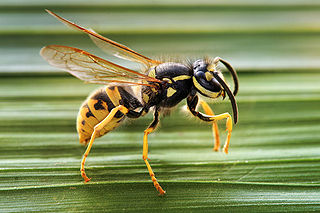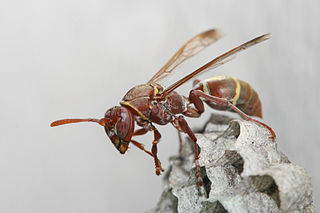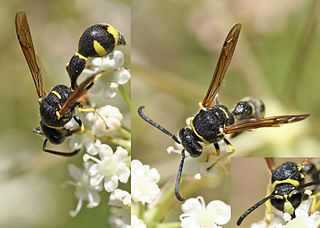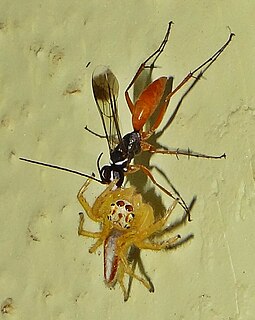
The Vespidae are a large, diverse, cosmopolitan family of wasps, including nearly all the known eusocial wasps and many solitary wasps. Each social wasp colony includes a queen and a number of female workers with varying degrees of sterility relative to the queen. In temperate social species, colonies usually last only one year, dying at the onset of winter. New queens and males (drones) are produced towards the end of the summer, and after mating, the queens hibernate over winter in cracks or other sheltered locations. The nests of most species are constructed out of mud, but polistines and vespines use plant fibers, chewed to form a sort of paper. Many species are pollen vectors contributing to the pollination of several plants, being potential or even effective pollinators, while others are notable predators of pest insect species.

Paper wasps are vespid wasps that gather fibers from dead wood and plant stems, which they mix with saliva, and use to construct nests made of gray or brown papery material. Some types of paper wasps are also sometimes called umbrella wasps, due to the distinctive design of their nests.

Halictidae is the second-largest family of bees with nearly 4,500 species. Halictid species are an extremely diverse group that can vary greatly in appearance. These bees occur all over the world and are found on every continent. Usually dark-colored and often metallic, halictids are found in various sizes, colors and patterns. Several species are all or partly green and a few are red, purple, or blue. A number of them have yellow markings, especially the males, which commonly have yellow faces, a pattern widespread among the various families of bees. The family is one of many with short tongues and is best distinguished by the arcuate basal vein found on the wing. Females in this family tend to be larger than the males.

The subfamily Vespinae contains the largest and best-known eusocial wasps, including true hornets, and the "yellowjackets". The remaining genus, Provespa, is a small, poorly known group of nocturnal wasps from Southeast Asia. One genus, Palaeovespa, has been described from the Eocene fossil record, from Colorado. Collectively, the group can be found on all continents except Antarctica, and several of these wasps are invasive species, introduced beyond their native ranges, and can be major pests.

The Polistinae is a subfamily of eusocial wasps belonging to the family Vespidae. They are closely related to the more familiar wasps and true hornets of the subfamily Vespinae, containing four tribes. With about 1,100 species total, it is the second-most diverse subfamily within the Vespidae, and while most species are tropical or subtropical, they include some of the most frequently encountered large wasps in temperate regions.

Potter wasps, the Eumeninae, are a cosmopolitan wasp group presently treated as a subfamily of Vespidae, but sometimes recognized in the past as a separate family, Eumenidae.

Eumenes is the type genus of the subfamily Eumeninae of Vespidae. It is a large and widespread genus, with over 100 taxa, mostly occurring in the temperate portions of the Northern Hemisphere. Most species are black or brown, and commonly marked with strikingly contrasting patterns of yellow, white, orange, or red. Like most vespids, their wings are folded longitudinally at rest. The first metasomal segment is narrow and elongated, creating a "bulbous" appearance to the abdomen.

Monobia is a primarily neotropical genus of medium-sized to large potter wasps occurring from the United States to Argentina. This genus is very closely related to the genus Montezumia. It contains the following species:

The Stenogastrinae are a subfamily of social wasps included in the family Vespidae. They are sometimes called hover wasps owing to the particular hovering flight of some species. Their morphology and biology present interesting peculiarities.
Abraham Willink was a Dutch-Argentine entomologist. His main contributions were made on the Hymenopteran families Vespidae, Sphecidae and Crabronidae. He also contributed to the classification of biogeographical provinces of Latin America. His role was of great interest in the decentralization of science, especially in Entomology in Argentina.
3 Genera and 52 species has been named after him.

Mass provisioning is a form of parental investment in which an adult insect, most commonly a hymenopteran such as a bee or wasp, stocks all the food for each of her offspring in a small chamber before she lays the egg. This behavior is common in both solitary and eusocial bees, though essentially absent in eusocial wasps.
Hypodynerus is a South American, primarily Andean, genus of potter wasps with most of its described species inhabiting Chile. The species included in Hypodynerus include:

Ropalidia marginata is an Old World species of paper wasp. It is primitively eusocial, not showing the same bias in brood care seen in other social insects with greater asymmetry in relatedness. The species employees a variety of colony founding strategies, sometimes with single founders and sometimes in groups of variable number. The queen does not use physical dominance to control workers; there is evidence of pheromones being used to suppress other female workers from overtaking queenship.

Belonogaster is a large genus of mainly Afrotropical quasisocial wasps, although some species occur in Arabia and two extend as far as India. They have characteristics of both the eusocial and the solitary wasps. Belonogaster constructs communal paper nests where the grubs are fed on masticated, soft-bodied insects such as caterpillars. The type species is Belonogaster juncea, which consists of two subspecies: Belonogaster juncea colonialis and Belonogaster juncea juncea. Belanogaster wasps are an important food source for wintering European honey buzzards in sub-Saharan Africa. In African traditional medicine, wasps of the genus are cooked with plant roots and consumed to cure various childhood sicknesses, as well as having ceremonial use similar to that of honey bees. Some birds choose to build their nests near the nests of Belonogaster for protection, including mousebirds and weavers.

Synoeca is a genus of eusocial paper wasps found in the tropical forests of the Americas. Commonly known as warrior wasps or drumming wasps, they are known for their aggressive behavior, a threat display consisting of multiple insects guarding a nest beating their wings in a synchronized fashion, and an extremely painful sting. The sting is barbed and if used often kills the wasp, which may be the reason why such a striking defensive display is used. This display escalates from drumming inside the nest to hundreds of wasps moving on to the envelope of the nest and of continuing to drum and only if this does not deter the threat do the wasps begin to sting.

Liostenogaster flavolineata is an insect that belongs to the wasp family Vespidae. This hairy-faced hover wasp species is predominantly found in South Asian rain forests, especially in Malaysia. Individual colonies of this species are very small, but aggregations of nests allow for interactions between many smaller colonies. Some worker wasps, known as "helpers", will move between multiple nests in an attempt to improve their position in the dominance hierarchy. Its nests are pale-colored and are usually built with mud. Liostenogaster flavolineata is one of the most studied species in the Stenogastrinae.
Liopteridae is a family of wood-boring parasitoid wasps. They occur worldwide with concentrations in the African Tropics. These insects have a petiolate abdomen. There are 10 genera and more than 140 species known.

Delta dimidiatipenne is a species of large, red-coloured potter wasp in the genus Delta that exists in the warmer regions of the Palearctic. Like many other potter wasps, it is a provisioning species that hunts caterpillars.

Ancistrocerus longispinosus is a species of potter wasp, belonging to the family Vespidae, subfamily Eumeninae.

Parischnogaster is a genus of hover wasps from the subfamily Stenogastrinae, a subfamily of eusocial wasps endemic to the Oriental Region which are included in the family Vespidae.

















